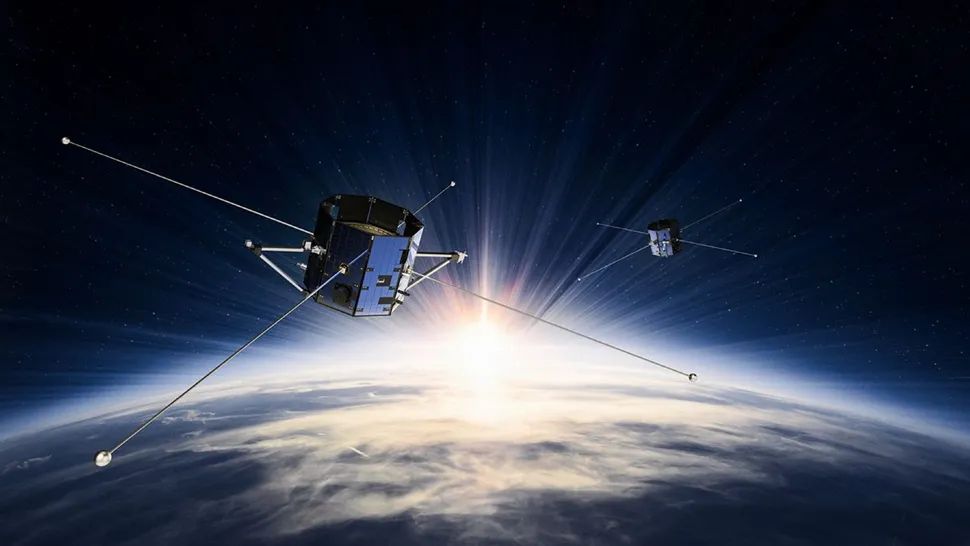OUR SPACE: TRACERS will study magnetic field lines
Published 10:42 am Tuesday, July 29, 2025

- An artist’s impression of the twin TRACERS spacecraft in orbit above Earth. (University of Iowa/Andy Kale)
There’s a new kid on the magnetic field block: the TRACERS mission will explore the effects of the solar wind on the Earth’s magnetic field lines. That’s the digest version of this innovative new mission; now let’s dive a little deeper and learn more about it.
TRACERS stands for Tandem Reconnection and Cusp Electrodynamics Reconnaissance Satellites. It sounds like a slightly tortured acronym at first, but it actually captures the mission goals very well. First off, we’re talking about twin satellites here (hence the Tandem). The identical spacecraft are octagonal in shape and roughly 3 by 4 feet in size. Reconnection is a technical term here — it refers to the point at Earth’s poles where the solar wind shoots into Earth’s atmosphere, along the magnetic field lines, which form roughly a funnel-shaped pattern called a cusp.
Solar wind pushing charged particles into Earth’s atmosphere is what causes auroras, or Northern Lights. While they are always pretty to watch, they are actually signs of potentially great danger. Our magnetic field protects us from the worst of it, but a good bit still gets through, and in some cases the overload of electrical charges thus delivered can overwhelm our rather fragile electrical grid and cause nasty rolling blackouts and the like, as well as premature aging of the electrical infrastructure itself. Satellites in orbit can also be affected. And this means your GPS directions might not work so well, and instead of directing you to the hotel you might end up in a swamp instead. Nobody likes such misdirection, but when the satellite coordinates are off your travel app will use this data and keep on advising you to drive in the wrong direction.
Trending
TRACERS is actually a follow-up to a previous mission called TRICE, conducted in late 2018 with sounding rockets. Sounding rockets do go into space but they do not go into orbit — they go more or less straight up and then come back down. During their flight they can gather all kinds of valuable data, and the TRICE mission sure did! TRACERS has the advantage of having two satellites working at the same time, following each other at a distance of ten seconds to two minutes, taking the same measurements. This will allow scientists to discern whether something is moving, accelerating or slowing down.
Each TRACERS satellite carries six science instruments on board, one of which is a technology demonstration of a new type of magnetometer, and its main goal is to prove that it does not interfere with or damage the other instruments on board, all of which are highly sensitive devices.
The TRACERS spacecraft launched into orbit on a rideshare mission — a total of nine satellites were delivered on the same rocket. Athena EPIC won a challenge by being put together in a mere seven months and it will be demonstrating an integrated system where other satellites control the spacecraft’s housekeeping chores, thus eliminating the need for its own processor. Weight saved is money saved in space travel!
The PExT satellite will explore ways to use different satellite communication systems, or languages, to talk back to the engineers on Earth. This will have huge implications for future missions; as the near-Earth environment gets increasingly crowded, communication links will be at a premium. A spacecraft that can communicate with several different existing networks can skip the waiting line for downloading data and just use whatever network is available.
The REAL CubeSat mission is a tiny satellite that will explore the types of particles that damage satellites, and what mechanism pulls them into the places where they can wreck another spacecraft.
Two other small satellites will test new space-based air traffic management systems and secure communications via 5G broadband access to enable connection with both rural and suburban areas. It’s relatively technical stuff but necessary for the development of newer, more efficient and, most of all, secure lines of communication.
Trending
The launch from Vandenberg Space Force Base was originally set for last Tuesday but was scrubbed a mere 45 seconds before launch due to crowded air traffic conditions — too much stuff flying overhead. Finding a hole in the ever-increasing network of near-Earth satellites through which you can launch your mission will become increasingly challenging as well, as you can imagine.
The whole kit’n’kaboodle finally took off last Wednesday and all satellites arrived safely in orbit. TRACERS will test and calibrate the two satellites for about a month and then they will be hard at work for at least a year. While the mission might not have the popular appeal of a crewed launch or a new space telescope, it is nonetheless an important mission, and one that will keep all of us safe and arriving at the correct place when travelling with the help of a GPS system.
Learn more about TRACERS at https://science.nasa.gov/mission/tracers/
—Beate Czogalla is the Professor of Theater Design in the Department of Theatre and Dance at Georgia College & State University. She has had a lifelong interest in space exploration and has been a Solar System Ambassador for the Jet Propulsion Laboratory/ NASA for many years. She can be reached at our_space2@yahoo.com .





